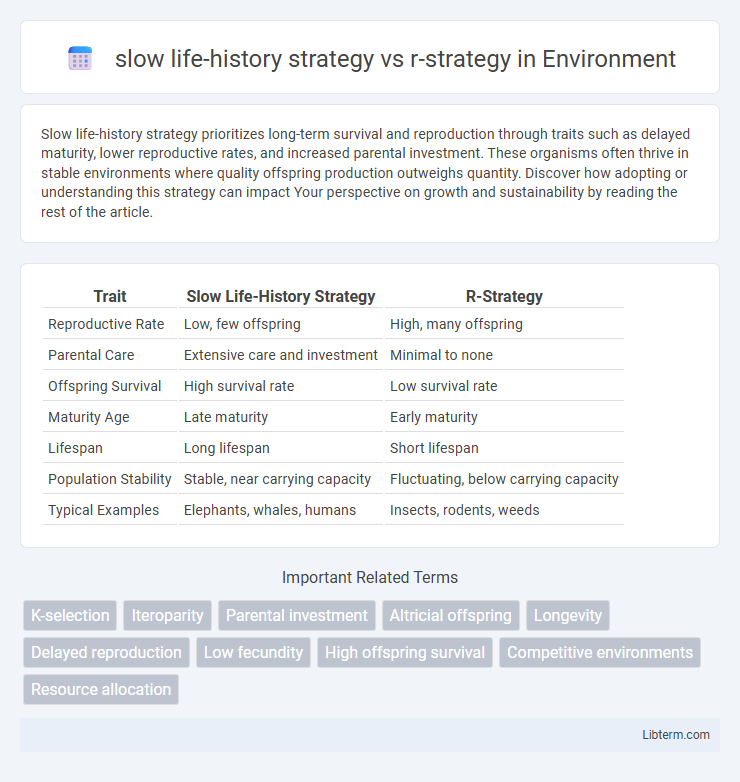Slow life-history strategy prioritizes long-term survival and reproduction through traits such as delayed maturity, lower reproductive rates, and increased parental investment. These organisms often thrive in stable environments where quality offspring production outweighs quantity. Discover how adopting or understanding this strategy can impact Your perspective on growth and sustainability by reading the rest of the article.
Table of Comparison
| Trait | Slow Life-History Strategy | R-Strategy |
|---|---|---|
| Reproductive Rate | Low, few offspring | High, many offspring |
| Parental Care | Extensive care and investment | Minimal to none |
| Offspring Survival | High survival rate | Low survival rate |
| Maturity Age | Late maturity | Early maturity |
| Lifespan | Long lifespan | Short lifespan |
| Population Stability | Stable, near carrying capacity | Fluctuating, below carrying capacity |
| Typical Examples | Elephants, whales, humans | Insects, rodents, weeds |
Understanding Slow Life-History Strategies
Slow life-history strategies emphasize traits such as delayed reproduction, low offspring quantity, and high parental investment, which maximize survival in stable environments. Species following this strategy, like elephants and whales, prioritize quality over quantity to enhance offspring fitness and longevity. By contrast, r-strategists produce numerous offspring with minimal care, thriving in unpredictable habitats where rapid reproduction ensures species persistence.
Defining r-Strategist Species
r-strategist species are characterized by high reproductive rates, producing numerous offspring with low parental investment, allowing rapid population growth in unpredictable or resource-rich environments. These species typically exhibit short lifespans, early maturity, and high mortality rates among juveniles, relying on quantity over quality for species survival. Examples include many insects, bacteria, and small rodents, which capitalize on transient conditions to maximize reproductive success.
Key Traits of Slow Life-History Strategists
Slow life-history strategists exhibit key traits such as delayed reproduction, extended lifespan, and reduced offspring quantity with increased parental investment. These traits promote survival in stable environments by ensuring higher offspring quality and greater resource allocation to each individual. Emphasis on longevity, low mortality rates, and steady population growth distinguishes slow strategists from r-strategists, who prioritize rapid reproduction and high offspring numbers.
Distinctive Features of r-Strategy Organisms
r-strategy organisms are characterized by high reproductive rates, producing numerous offspring with minimal parental investment to maximize survival chances in unpredictable environments. These species typically exhibit rapid development, early maturity, and short lifespans, prioritizing quantity over quality in offspring production. Adaptations such as opportunistic resource use and high dispersal capacity allow r-strategists to quickly colonize available habitats and exploit transient resources.
Environmental Influences on Life-History Strategies
Environmental stability and resource availability critically shape life-history strategies, with slow life-history species thriving in stable, resource-limited environments through traits like delayed reproduction and extended lifespan. In contrast, r-strategy species adapt to unpredictable, resource-rich habitats by reproducing rapidly and producing many offspring to maximize short-term survival. These environmental pressures drive evolutionary trade-offs in growth, reproduction, and survival, optimizing species' fitness in their specific ecological contexts.
Reproductive Patterns in Both Strategies
Slow life-history strategy is characterized by delayed reproduction, fewer offspring, and high parental investment, promoting offspring survival in stable environments. In contrast, r-strategy involves early reproduction, producing many offspring with minimal parental care, optimizing rapid population growth in unpredictable habitats. These reproductive patterns reflect adaptations to environmental stability and resource availability, influencing species' survival and evolutionary success.
Survival and Longevity Comparisons
Organisms exhibiting slow life-history strategies typically invest more in individual survival and longevity, characterized by traits such as delayed reproduction, fewer offspring, and extended parental care, enhancing their chances of surviving in stable or competitive environments. In contrast, r-strategy species emphasize rapid reproduction with minimal investment per offspring, resulting in high fecundity but reduced individual survival rates and shorter lifespans, adapted to unpredictable or changing habitats. Survival rates for slow strategists are generally higher due to energy allocation toward maintenance and defense mechanisms, whereas r-strategists rely on producing numerous offspring to offset high mortality risks.
Trade-Offs: Quality vs. Quantity in Offspring
Slow life-history strategies emphasize producing fewer offspring with higher parental investment, enhancing offspring survival and quality through resource allocation and care. In contrast, r-strategies favor producing many offspring with minimal investment per individual, maximizing quantity to exploit unpredictable environments despite higher mortality rates. The trade-off revolves around optimizing reproductive success by balancing offspring number against survival probability under different ecological conditions.
Evolutionary Contexts and Adaptations
Slow life-history strategies involve organisms evolving traits such as delayed reproduction, longer lifespans, and greater parental investment, optimizing survival in stable environments with limited resources. In contrast, r-strategists reproduce rapidly with minimal parental care, maximizing offspring quantity to exploit unpredictable or disturbed habitats. Evolutionarily, these adaptations reflect selective pressures shaping reproductive timing and investment, balancing survival and reproductive success across ecological contexts.
Implications for Conservation and Management
Slow life-history strategies, characterized by longer lifespans, delayed reproduction, and lower fecundity, make species more vulnerable to environmental disturbances and overexploitation, necessitating careful population monitoring and habitat protection. In contrast, r-strategists, which reproduce rapidly and have high fecundity, can recover more quickly from population declines but may require management to prevent overpopulation and ecosystem imbalance. Conservation plans must tailor interventions to these strategies, prioritizing protection of slow strategists' stable habitats and controlling resource competition for r-strategists to maintain biodiversity and ecosystem stability.
slow life-history strategy Infographic

 libterm.com
libterm.com